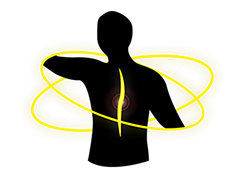
Rigid-sole shoes are mandatory.
Without exception, the Practitioner requires that patients wear shoes with a rigid sole to perform the evaluation and measure the legs.
The following are not acceptable:
- Bare feet
- Socks
- Sandals (flip flops), including Crocs
- Slippers
- Moccasins
- All types of boots (they restrict the ankle movement)
Evaluation
The first step is to evaluate the muscular, skeletal, and visceral systems to locate impingements and compare your legs’ alignment with your body (using a leg-test). This test helps to detect the source of the impingements and measure how intensely your systems are inhibited.
This test is done before every treatment to note any
changes and progress.
As part of the evaluation, the patient is asked to lay face down on the correction bench; to ensure the shoes do not fall off, shoes must be closed in the back. Improper footwear may render the testing method less accurate.
Patients appreciate this non-invasive evaluation because:
- They do not disrobe
- There are no blood tests
- No medication is administered
- There are no stressful movements
- No machinery is involved
The likelihood that debris and dirt transfers to your clothing and skin from your shoes during the treatment is high, so to prevent this from happening, please inspect your footwear before entering the correction room.
Note: Improper footwear interferes with the leg-test evaluation and requires additional
time, which impacts the Practitioner’s schedule. As a result, a surcharge may be added to the usual fee for those who repeatedly forget.
Manual Correction
Once the internal source of the impingement is located, the Practitioner applies a specific sequence of manual thrusts on the troubled area creating Resonance Activating Core Equilibrium (R.A.C.E.).
The manual thrusts help the body engage the auto-correction process, which releases or alleviates tensions and pressures that disturb the skeletal structures and internal systems. During this process, increased circulation, respiration and improved digestion delivers more blood, vital oxygen and nutrients through the body allowing your systems to function at a greater capacity and with greater ease.
Factors such as the patient’s age, size, weight, lifestyle, habits, and work environment influence the auto-correction process ultimately determining the recovery time.
To allow the body to efficiently process the intent of the treatment, it is recommended that clients avoid intense exercise or strenuous work for several hours after a correction. Once the technique has been applied, the body needs several days to process the correction. The Practitioner will establish the optimal wait time between corrections. As the body corrects and becomes stronger and better aligned, the treatments will be spaced further apart.
Note: Our practitioners are not doctors, therefore, they cannot diagnose, nor can they prescribe medication or predict the results of the recovery.
Adaption Stage
Following treatment, some patients experience an increase in energy while others feel the need to rest. It is often reported by patients that no apparent changes are noted or felt following the initial treatments, which is normal. The variations can be attributed to which torsion and compression is releasing within the support systems.
For the majority of patients, the changes are more noticeable by the fourth or fifth treatment. Relatively soon into the treatments, many of our patients experience deeper breathing, feel more energetic, have improved digestion and a decrease in bloating. Many even express how their posture has noticeably improved: they feel taller and their shoulders are more relaxed.
A lifetime of specific events has created your own personal present health condition; this is why recovery can vary between patients.
Maintenance Therapy
Once your body has achieved the most that the R.A.C.E. technique can offer, we recommend returning for maintenance at the change of every season. This will give you a better chance of retaining your level of wellness.
An active lifestyle and healthy eating habits are also highly recommended to help reduce the abuse and stress on the internal systems. Getting plenty of sleep will also help ensure you are fully rested and not lethargic during the day.
LOCATION
VARS (Ottawa region)
Martin Skody
Simone Duval
Erika Skody
1866 Alcide Avenue
Unit 1
Vars ON K0A 3H0
© Copyright 2025. R.A.C.E | racetherapy.ca
